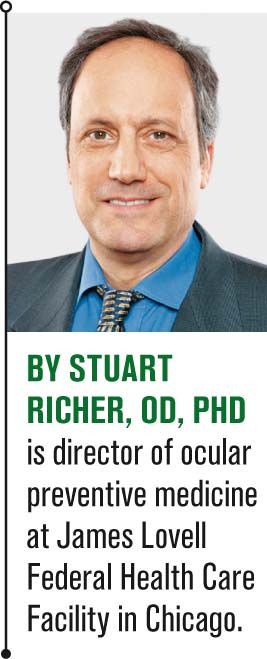Why AMD supplementation should not be casual
The treatment of age-related macular degeneration (AMD) with supplements shouldn't be left to chance. Stuart Richer, OD, PhD, FAAO, discusses why gambling with AMD supplementation may be risky.


Editor’s note: This article has been updated with additional information for clarity.
I disagree with an ongoing claim that supplementation with three retinal carotenoids (lutein [L], zeaxanthin [Z], meso-zeaxanthin [MZ]) on a long-term basis, is superior to supplementing with only two dietary carotenoids (L and Z).1 At the same time I’m excited about the potential short-term use of fovea-targeted supplementation, either Z or MZ, in late-stage AMD.
For clinicians who prescribe supplements other than Age-Related Eye Disease Study (AREDS) II for high-risk age-related macular degeneration (AMD) patients or consider prescribing the same carotenoid components for low- and moderate-risk AMD patients, the results from the recent CREST 2 study (Central Retinal Enrichment Supplementation Trial) data may be instructive.2
What CREST 2 tells us
CREST 2 evaluated the impact of supplementation with all three macular carotenoids in early AMD.3 MZ is important because, along with its dietary isomer Z, it is concentrated mostly in the fovea. MZ is not present in any other ocular or systemic tissue, including skin and brain, and there is no common dietary source. There is an ongoing debate, concerning whether MZ is synthetic, semi-synthetic or pharmacologic.
Previously from Dr. Richer: ODs’ role promising in detecting Alzheimer’s disease
CREST 2 was a two-year, randomized, double-blind, controlled study that evaluated a lower 25 mg zinc (Zn)/AREDS II formulation vs. 25 mg Zn/AREDS II + 10 mg MZ in minimal risk AMD patients. The single clinical site study originates from carotenoid scientists at the Macular Pigment Research Group in Ireland, a country where AMD is a public health concern.4
CREST 2 visual outcome data
The primary CREST 2 outcome measure was letter contrast sensitivity (CS) at six cycles per degree-which is different from the high spatial frequencies typically employed during routine eye exams. CS, not visual acuity, is closer to how patients see in everyday life.
CREST 2 showed no difference in this primary outcome (p=0.88). The global improvement in CS and each of the secondary measures of visual function were virtually identical with or without the addition of 10 mg MZ. Indeed, multiple prior studies have shown that AREDS-dosed xanthophyll carotenoid (L and Z) supplementation improves CS without the 10 mg MZ used in the CREST 2 study.5-10
Paul Bernstein, MD, PhD, and his team at the Moran Institute in Salt Lake City, UT, have looked at both transporter and retinal binding proteins for the three retinal carotenoids. As part of that research, they demonstrated the ubiquitous isomerase enzyme RPE65 is responsible for the conversion of L to MZ in vertebrates, implying that retinal MZ is readily available to those who supplement with L 11,12
This is a unique role for RPE65 beyond its well-known isomerization of all-trans-retinyl esters to 11-cis-retinol in the vertebrate visual cycle.12 The conversion occurs in the retinal pigment epithelium (RPE).13 L is considered so important for eye and brain health that a new publication calls for the establishment of a Dietary Reference Intake (DRI).14
Short-term anti-VEGF enhancement
Lost in conversation among retinal specialists and unnoticed by competition among supplement manufacturers is evidence that these two molecules target the fovea and complement intravitreal injections. Specifically, two high-dose Z AMD published clinical studies show an improvement in vision, reduction in fellow eye neovascularization, and decrease in treatment cycles over a two-year time frame.15,16
Related: Details matter when prescribing meso-zeaxanthin
However, information shared from the podium at a January continuing education meeting offered new insight. Retinal specialist Michael Tolentino, MD, showed case reports (n=38, unpublished) of several high-risk AMD patients cotreated with both anti-VEGF agents and MLZ. Within his clinical practice, Dr. Tolentino said he typically lengthens the anti-VEGF treatment interval from six weeks to as long as six months.17 Further studies are needed to evaluate MLZ and high-dose Z in this context.
Long-term MZ use
Consistent with inferiority in stressed visual situations, careful examination of CREST 2 data shows depression of serum L, Z, and total carotenoids despite a near doubling of the carotenoid dose with an enriched 10 mg MZ + AREDS II carotenoids formula. In CREST 2, the MZ enhanced formulation dramatically diminished serum Z levels (p=0.005).
This is concerning because dietary L and Z have recently emerged as crucial, if not essential, brain nutrients.18,19 More work needs to be done addressing the issue of carotenoid competition. To be fair, high Z supplementation could theoretically decrease serum L and should be studied in controlled nutritional studies.
Finally, I disagree that triple carotenoid formulas are essential for normalizing atypical central dips in macular pigment spatial profiles.1 Imaging studies are certainly necessary to confirm these psychophysical findings.
Our laboratory has published preliminary imaging evidence to the contrary.20 In a few patients, dietary Z was capable of normalizing central foveal macular pigment dips. It is likely 2 mg of dietary Z employed within AREDS II and CREST 2 may not be adequate-especially considering the 1:1:1 ratio of L:Z:MZ found in the human fovea.
In summary
My current understanding is that cosupplementing with high-dose Z or MLZ (containing M, the stereoisomer of dietary Z) may in the short term enhance current AMD management and may potentially diminish the number of intravitreal injections. The National Eye Institute should play a role in sorting this out in well-controlled, carefully designed post AREDS II high-dose Z studies.
References
1. Dierker D. What Are Carotenoids-And Are Two of Them Enough? Optometric Management. Available at: https://www.optometricmanagement.com/newsletters/nutritional-insights-for-clinical-practice/november-2017. Accessed 1/11/18.
2. Akuffo KO, Beatty S, Peto T, Stack J, Stringham J, Kelly D, Leung I, Corcoran L, Nolan JM. The Impact of Supplemental Antioxidants on Visual Function in Nonadvanced Age-Related Macular Degeneration: A Head-to-Head Randomized Clinical Trial. Invest Ophthalmol Vis Sci. 2017 Oct 1;58(12):5347-5360.
3. Centres and Groups Macular Pigment Research Group. Waterford Institute of Technology. Available at: https://www.wit.ie/research/centres_and_groups/research_groups/science/macular_pigment_research_group. Accessed 1/11/18.
4. Akuffo KO, Nolan J, Stack J, Moran R, Feeney J, Kenny RA, Peto T, Dooley C, O’Halloran AM, Cronin H, Beatty S. Prevalence of age-related macular degeneration in the Republic of Ireland. Br JOphthalmol. 2015 Aug;99:1037–1044.
5. Stringham JM, Hammond BR. Macular pigment and visual performance under glare conditions. Optom Vis Sci. 2008 Feb;85(2):82-8.
6. Hammond BR, Fletcher LM, Roos F, Wittwer J, Schalch W. A double-blind, placebo-controlled study on the effects of lutein and zeaxanthin on photostress recovery, glare disability, and chromatic contrast. Invest Ophthalmol Vis Sci. 2014 Dec 2;55(12):8583-9. doi: 10.1167/iovs.14-15573.
7. Obana A, Tanito M, Gohto Y, Okazaki S, Gellermann W, Bernstein PS. Changes in Macular Pigment Optical Density and Serum Lutein Concentration in Japanese Subjects Taking Two Different Lutein Supplements. PLoS One. 2015 Oct 9;10(10):e0139257.
8. Nolan JM, Loughman , Akkali MC, Stack J, Scanlon G, Davison P, Beatty S. The impact of macular pigment augmentation on visual performance in normal subjects: COMPASS. Vision Res. 2011 Mar 2;51(5):459-69.
9. Loughman J, Nolan JM, Howard AN, Connolly E, Meagher K, Beatty S. The impact of macular pigment augmentation on visual performance using different carotenoid formulations. Invest Ophthalmol Vis Sci. 2012 Nov 29;53(12):7871-80.
10. Stringham JM, O'Brien KJ, Stringham NT. Contrast Sensitivity and Lateral Inhibition Are Enhanced With Macular Carotenoid Supplementation. Invest Ophthalmol Vis Sci. 2017 Apr 1;58(4):2291-2295.
11. Shyam R, Vachali P, Gorusupudi A, Nelson K, Bernstein PS. All three human scavenger receptor class B proteins can bind and transport all three macular xanthophyll carotenoids. Arch Biochem Biophys. 2017 Nov 15;634:21-28
12. Shyam R, Gorusupudi A, Nelson K, Horvath MP, Bernstein PS. RPE65 has an additional function as the lutein to meso-zeaxanthin isomerase in the vertebrate eye. Proc Natl Acad Sci U S A. 2017 Oct 10;114(41):10882-10887.
13. Gorusupudi A, Shyam R, Li B, Vachali P, Subhani YK, Nelson K, Bernstein PS. Developmentally Regulated Production of meso-Zeaxanthin in Chicken Retinal Pigment Epithelium/Choroid and Retina. Invest Ophthalmol Vis Sci. 2016 Apr;57(4):1853-61.
14. Ranard KM, Jeon S, Mohn ES, et al. Dietary guidance for lutein: consideration for intake recommendations is scientifically supported. Eur J Nutr. 2017 Dec;56 (Suppl 3):37-42.
15. Olk RJ, Peralta E, Gierhart DL, Brown MM, Brown GC (2017) Combination Therapy with Dietary Zeaxanthin for Neovascular Age-Related Macular Degeneration. A Randomized Clinical Trial. J Clin Exp Ophthalmol 8: 692. Doi: 10.4172/2155-9570.1000692.
16. Olk JR, Peralta E, Gierhart DL, Brown MM, Brown GC. Triple combination therapy and zeaxanthin for the treatment of neovascular age- related macular degeneration: an interventional comparative study and cost- effectiveness analysis. Int J Ret Vitreous. 2015;1:22.
17. Tolentino M. Nutrition & Disease Management. West Suburban Optometric Society Meeting & CE. 28 January 2018; Naperville, IL.
18. Vishwanathan R, Neuringer M, Snodderly DM, Schalch W, Johnson EJ. Macular lutein and zeaxanthin are related to brain lutein and zeaxanthin in primates. Nutr Neurosci. 2013 Jan;16(1):21-9.
19. Hoffmann KG, Richer SP, Wrobel JS, Chen E, Podella CJ. Prospective Study of Neuro-Cognitive Enhancement with Carotenoids in Elderly Adult Males with Early Age Related Macular Degeneration, Ophthalmology Research: An International Journal. 2015. 4(1):1-8.
20. Richer SP, Cebold B, Katkar M, Huntjens B, Pratt SG, Stiles W, Ulanski L, Gierhart D. Restoration of Central Macular Pigment Dip with Dietary RR Zeaxanthin Supplementation in Patients with AMD. Adv Ophthalmol Vis Syst. 7(3): 00219.
Newsletter
Want more insights like this? Subscribe to Optometry Times and get clinical pearls and practice tips delivered straight to your inbox.